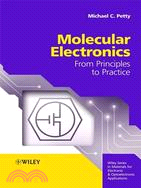MOLECULAR ELECTRONICS - FROM PRINCIPLES TO PRACTICE
商品資訊
ISBN13:9780470013083
出版社:JOHN WILEY & SONS;LTD
作者:PETTY
出版日:2007/11/16
裝訂/頁數:平裝/544頁
商品簡介
目次
Preface.
Acknowledgements.
Major Symbols and Abbreviations.
1. Scope of Molecular Electronics.
1.1 Introduction.
1.2 Molecular Materials for Electronics.
1.3 Molecular-scale Electronics.
1.3.1 Evolution of Microelectronics.
1.3.2 Moore's Laws.
1.3.3 Beyond Moore.
1.4 The Biological World.
1.5 Future Opportunities.
1.6 Conclusions.
Bibliography.
References.
2. Materials' Foundations.
2.1 Introduction.
2.2 Electronic Structure.
2.2.1 Atomic Structure.
2.2.2 Electrons in Atoms.
2.2.3 Filling of Orbitals.
2.2.4 The Periodic Table.
2.3 Chemical Bonding.
2.3.1 Bonding Principles.
2.3.2 Ionic Bond.
2.3.3 Covalent Bond.
2.3.4 Metallic Bonding.
2.3.5 Van der Waals Bonding.
2.3.6 Hydrogen Bonding.
2.4 Bonding in Organic Compounds.
2.4.1 Hybridized Orbitals.
2.4.2 Isomers.
2.4.3 Double and Triple Bonds.
2.5 Crystalline and Noncrystalline Materials.
2.5.1 States of Matter.
2.5.2 Phase Changes and Thermodynamic Equilibrium.
2.5.3 The Crystal Lattice.
2.5.4 Crystal Systems.
2.5.5 Miller Indices.
2.5.6 Distance Between Crystal Planes.
2.5.7 Defects.
2.5.8 Amorphous Solids.
2.6 Polymers.
2.6.1 Molecular Weight.
2.6.2 Polymer Structure.
2.6.3 Polymer Crystallinity.
2.7 Soft Matter: Emulsions, Foams and Gels.
2.8 Diffusion.
Bibliography.
Reference.
3. Electrical Conductivity.
3.1 Introduction.
3.2 Classical Theory.
3.2.1 Electrical Conductivity.
3.2.2 Ohm's Law.
3.2.3 Charge Carrier Mobility.
3.2.4 Fermi Energy.
3.3 Energy Bands in Solids.
3.3.1 Quantum Mechanical Foundations.
3.3.2 Kronig-Penney Model.
3.3.3 Conductors, Semiconductors and Insulators.
3.3.4 Electrons and Holes.
3.3.5 Intrinsic and Extrinsic Conduction.
3.3.6 Quantum Wells.
3.3.7 Disordered Semiconductors.
3.3.8 Conductivity in Low-dimensional Solids.
3.4 Organic Compounds.
3.4.1 Band Structure.
3.4.2 Doping.
3.4.3 Solitons, Polarons and Bipolarons.
3.4.4 Superconductivity.
3.5 Low-frequency Conductivity.
3.5.1 Electronic Versus Ionic Conductivity.
3.5.2 Quantum Mechanical Ttunnelling.
3.5.3 Variable Range Hopping.
3.5.4 Space-charge Injection.
3.5.5 Schottky and Poole-Frenkel Effects.
3.6 Conductivity at High Frequencies.
3.6.1 Complex Permittivity.
3.6.2 Impedance Spectroscopy.
Bibliography.
References.
4. Optical Phenomena.
4.1 Introduction.
4.2 Electromagnetic Radiation.
4.3 Refractive Index.
4.3.1 Permittivity Tensor.
4.3.2 Linear and Nonlinear Optics.
4.4 Interaction of EM Waves with Organic Molecules.
4.4.1 Absorption Processes.
4.4.2 Aggregate Formation.
4.4.3 Excitons.
4.4.4 Effect of Electric Fields on Absorption.
4.4.5 Emission Processes.
4.4.6 Energy Transfer.
4.5 Transmission and Reflection from Interfaces.
4.5.1 Laws of Reflection and Refraction.
4.5.2 Fresnel Equations.
4.5.3 Ellipsometry.
4.5.4 Thin Films.
4.6 Waveguiding.
4.7 Surface Plasmons.
4.7.1 The evanescent Field.
4.7.2 Surface Plasmon Resonance.
4.8 Photonic Crystals.
4.8.1 Subwavelength Optics.
Bibliography.
References.
5. Electroactive Organic Compounds.
5.1 Introduction.
5.2 Selected Topics in Chemistry.
5.2.1 Moles and Molecules.
5.2.2 Acids and Bases.
5.2.3 Ions.
5.2.4 Solvents.
5.2.5 Functional Groups.
5.2.6 Aromatic Compounds.
5.3 Conductive Polymers.
5.4 Charge-transfer Complexes.
5.5 Buckyballs and Nanotubes.
5.5.1 Fullerenes.
5.5.2 Carbon Nanotubes.
5.6 Piezoelectricity, Pyroelectricity and Ferroelectricity.
5.6.1 Basic Principles.
5.6.2 Organic Piezoelectric, Pyroelectric and Ferroelectric Compounds.
5.7 Magnetic Materials.
5.7.1 Basic Principles.
5.7.2 Organic Magnets.
Bibliography.
References.
6. Tools for Molecular Electronics.
6.1 Introduction.
6.2 Direct Imaging.
6.2.1 Optical Microscopy.
6.2.2 Electron Microscopy.
6.3 X-ray Reflection.
6.3.1 Electron Density Profile.
6.3.2 Keissig Fringes.
6.3.3 In-plane Measurements.
6.4 Neutron Reflection.
6.5 Electron Diffraction.
6.6 Infrared Spectroscopy.
6.6.1 Raman Scattering.
6.7 Surface Analytical Techniques.
6.8 Scanning Probe Microscopies.
6.9 Film Thickness Measurements.
Bibliography.
References.
7. Thin Film Processing and Device Fabrication.
7.1 Introduction.
7.2 Established Deposition Methods.
7.2.1 Spin-coating.
7.2.2 Physical Vapour Deposition.
7.2.3 Chemical Vapour Deposition.
7.2.4 Electrochemical Methods.
7.2.5 Inkjet Printing.
7.2.6 Sol-gel Processing.
7.2.7 Other Techniques.
7.3 Molecular Architectures.
7.3.1 Langmuir-Blodgett Technique.
7.3.2 Chemical Self-assembly.
7.3.3 Electrostatic Layer-by-layer Deposition.
7.4 Nanofabrication.
7.4.1 Photolithography.
7.4.2 Nanometre Pattern Definition.
7.4.3 Soft Lithography Techniques.
7.4.4 Scanning Probe Manipulation.
7.4.5 Dip-pen Nanolithography.
7.4.6 Other Methods.
Bibliography.
References.
8. Liquid Crystals and Devices.
8.1 Introduction.
8.2 Liquid Crystal Phases.
8.2.1 Thermotropic Liquid Crystals.
8.2.2 Lyotropic Liquid Crystals.
8.3 Liquid Crystal Polymers.
8.4 Display Devices.
8.4.1 Birefringence.
8.4.2 Freedericksz Transition.
8.4.3 Twisted Nematic Display.
8.4.4 Passive and Active Addressing.
8.4.5 Full-colour Displays.
8.4.6 Super-twisted Nematic Display.
8.5 Ferroelectric Liquid Crystals.
8.6 Polymer-dispersed Liquid Crystals.
8.7 Liquid Crystal Lenses.
8.8 Other Application Areas.
Bibliography.
References.
9. Plastic Electronics.
9.1 Introduction.
9.2 Organic Diodes.
9.2.1 Schottky Diode.
9.2.2 Ohmic Contacts.
9.3 Metal-Insulator-Semiconductor Structures.
9.3.1 Idealized MIS Device.
9.3.2 Organic MIS Structures.
9.4 Field Effect Transistors.
9.5 Integrated Organic Circuits.
9.5.1 Radiofrequency Identification Tags.
9.6 Organic Light-emitting Displays.
9.6.1 Device Efficiency.
9.6.2 Methods of Efficiency Improvement.
9.6.3 Full-colour Displays.
9.6.4 Electronic Paper.
9.7 Photovoltaic Cells.
9.7.1 Organic Semiconductor Solar Cell.
9.7.2 Dye-sensitized Solar Cell.
9.7.3 Luminescent Concentrator.
9.8 Other Application Areas.
9.8.1 Conductive Coatings.
9.8.2 Batteries and Fuel Cells.
9.8.3 Xerography.
Bibliography.
References.
10. Chemical Sensors and Actuators.
10.1 Introduction.
10.2 Sensing Systems.
10.3 Definitions.
10.4 Chemical Sensors.
10.4.1 Calorimetric Gas Sensors.
10.4.2 Electrochemical Cells.
10.4.3 Resistive Gas Sensors.
10.4.4 Dielectric Sensors.
10.4.5 Acoustic Devices.
10.4.6 Optical Sensors.
10.5 Biological Olfaction.
10.6 Electronic Noses.
10.7 Physical Sensors and Actuators.
10.7.1 Touch Sensors.
10.7.2 Polymer Actuators.
10.7.3 Lab-on-a-chip.
10.8 Smart Textiles and Clothing.
Bibliography.
References.
11. Molecular-scale Electronics.
11.1 Introduction.
11.2 Nanosystems.
11.2.1 Scaling Laws.
11.2.2 Interatomic Forces.
11.3 Engineering Materials at the Molecular Level.
11.3.1 Polar Materials.
11.3.2 Nonlinear Optical Materials.
11.3.3 Photonic Crystals.
11.4 Electronic Device Architectures.
11.5 Molecular Rectification.
11.6 Electronic Switching and Memory Devices.
11.6.1 Resistive Bistable Devices.
11.6.2 Flash Memories.
11.6.3 Spintronics.
11.6.4 Three-dimensional Architectures.
11.7 Single-electron Devices.
11.8 Optical and Chemical Switches.
11.8.1 Fluorescence Switching.
11.8.2 Photochromic Systems.
11.8.3 Chemical Control.
11.9 Nanomagnetic Systems.
11.10 Nanotube Electronics.
11.11 Molecular Actuation.
11.11.1 Dynamically Controllable Surfaces.
11.11.2 Rotaxanes.
11.11.3 Optical Tweezers.
11.12 Logic Circuits.
11.13 Computing Architectures.
11.14 Quantum Computing.
Bibliography.
References.
12. Bioelectronics.
12.1 Introduction.
12.2 Biological Building Blocks.
12.2.1 Amino Acids and Peptides.
12.2.2 Proteins.
12.2.3 Enzymes.
12.2.4 Carbohydrates.
12.2.5 Lipids.
12.3 Nucleotides.
12.3.1 Bases.
12.3.2 DNA.
12.3.3 RNA.
12.3.4 ATP, ADP.
12.4 Cells.
12.5 Genetic Coding.
12.5.1 Replication, Transcription and Translation.
12.6 The Biological Membrane.
12.6.1 Transport Across the Membrane.
12.7 Neurons.
12.8 Biosensors.
12.8.1 Biocatalytic Sensors.
12.8.2 Bioaffinity Sensors.
12.9 DNA Electronics.
12.10 Photobiology.
12.10.1 Bacteriorhodopsin.
12.10.2 Photosynthesis.
12.11 Molecular Motors.
12.11.1 Nature's Motors.
12.11.2 Artificial Motors.
Bibliography.
References.
Index.
主題書展
更多書展今日66折
您曾經瀏覽過的商品
購物須知
為了保護您的權益,「三民網路書店」提供會員七日商品鑑賞期(收到商品為起始日)。
若要辦理退貨,請在商品鑑賞期內寄回,且商品必須是全新狀態與完整包裝(商品、附件、發票、隨貨贈品等)否則恕不接受退貨。
























